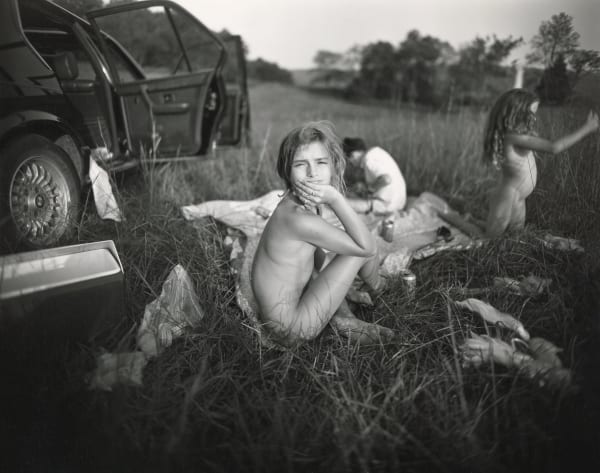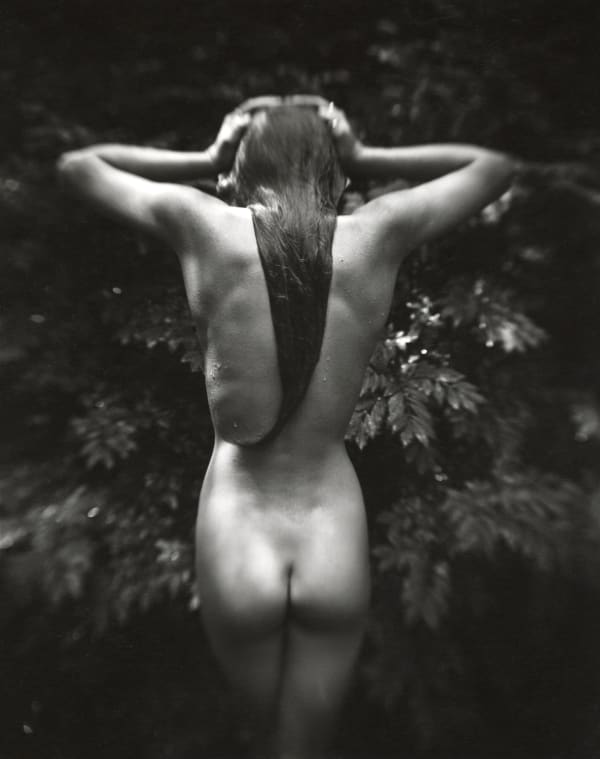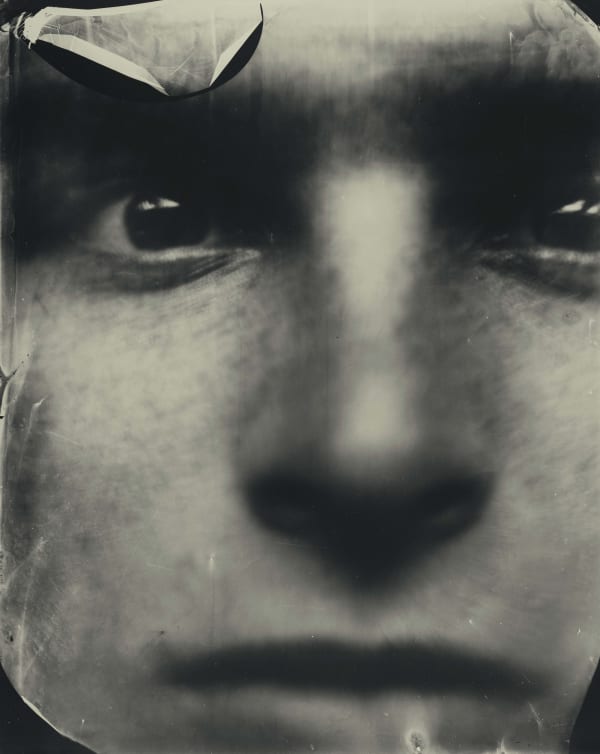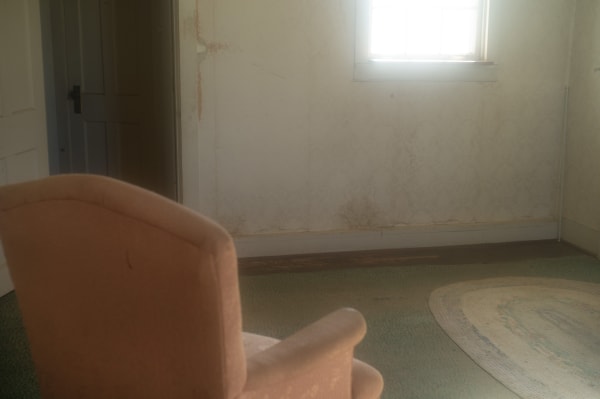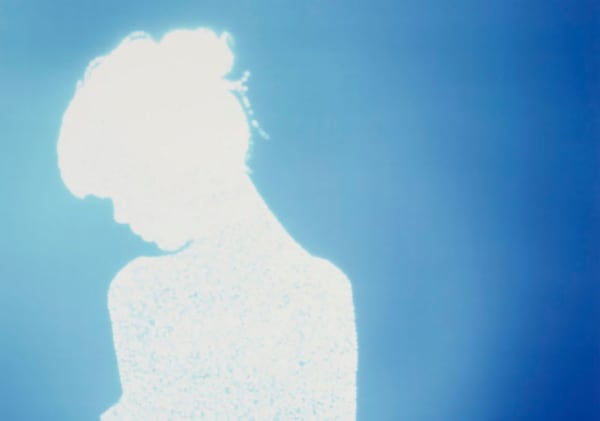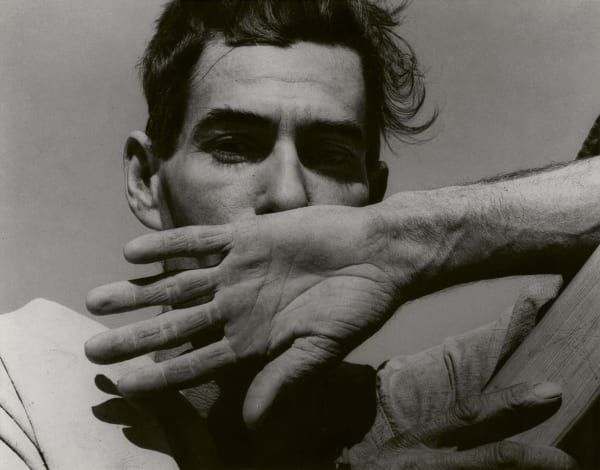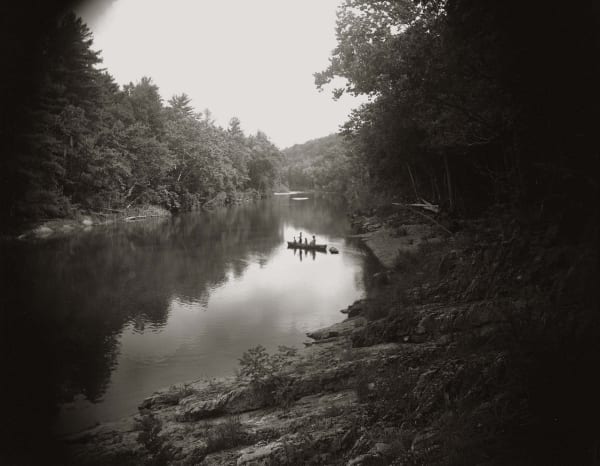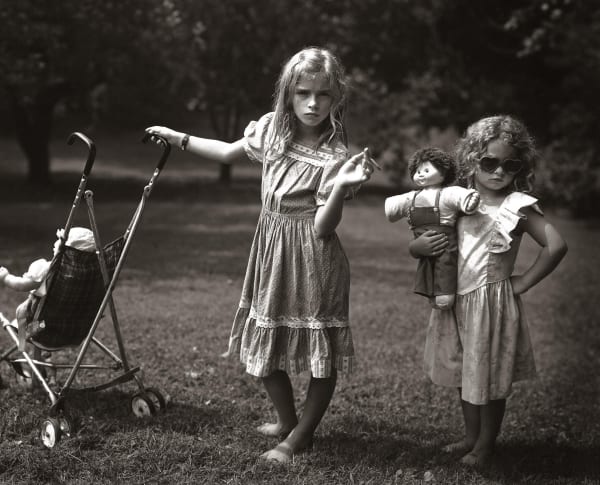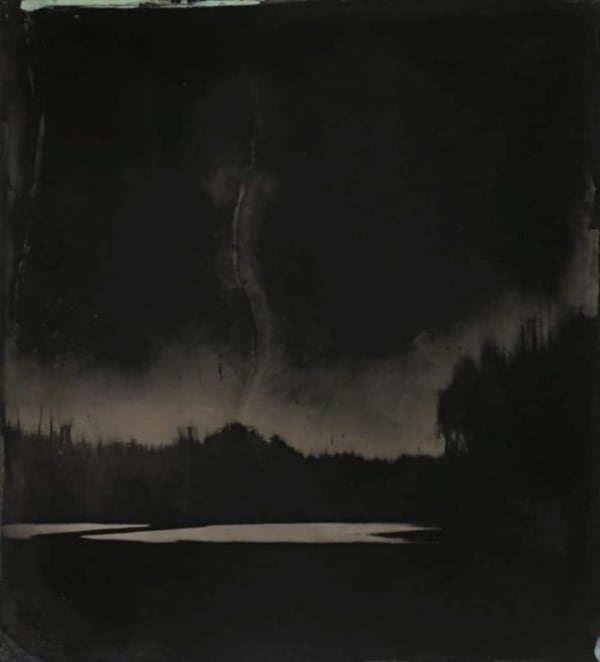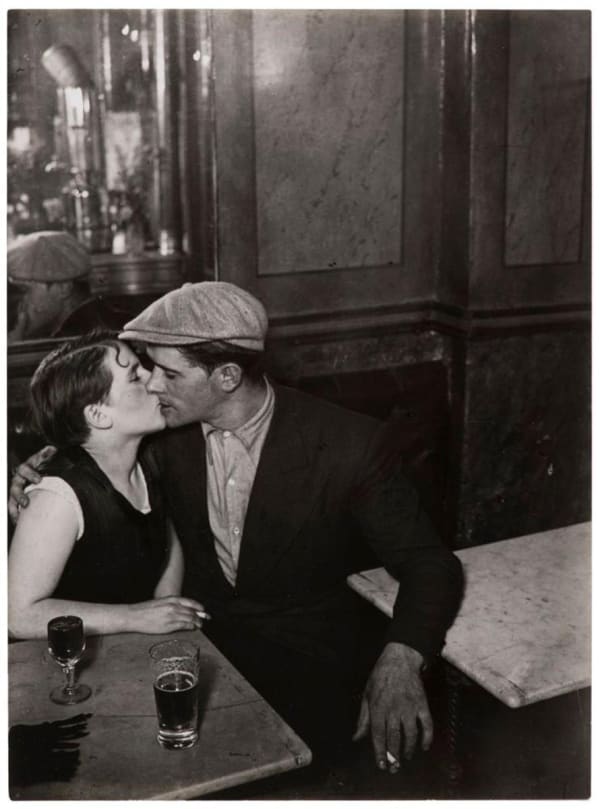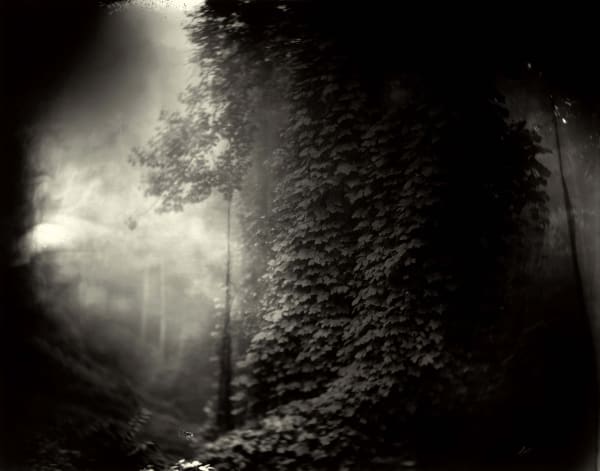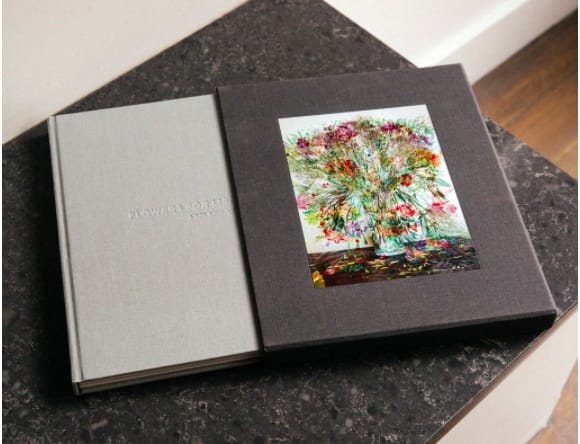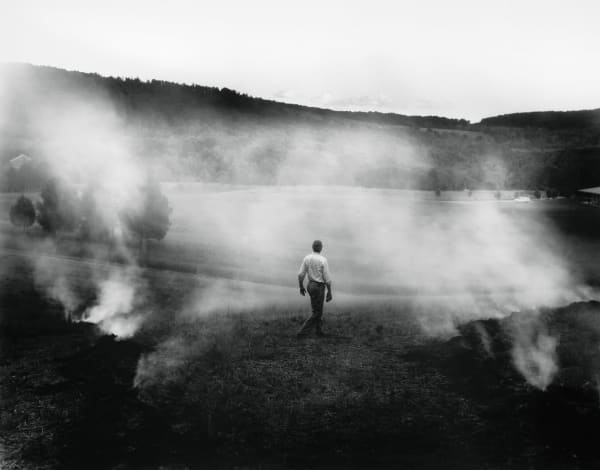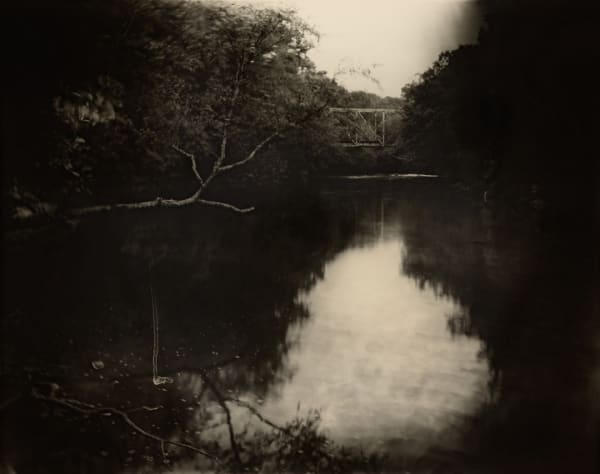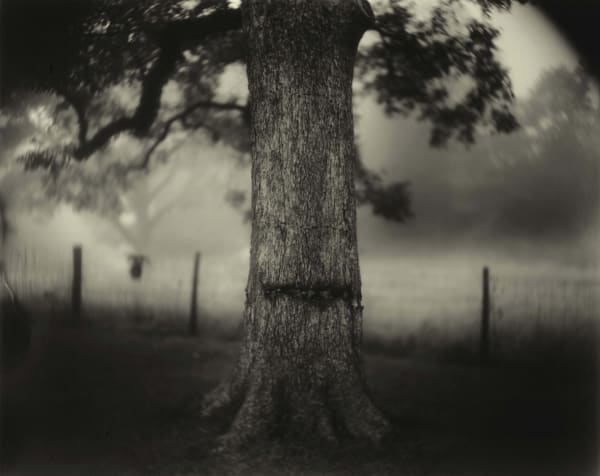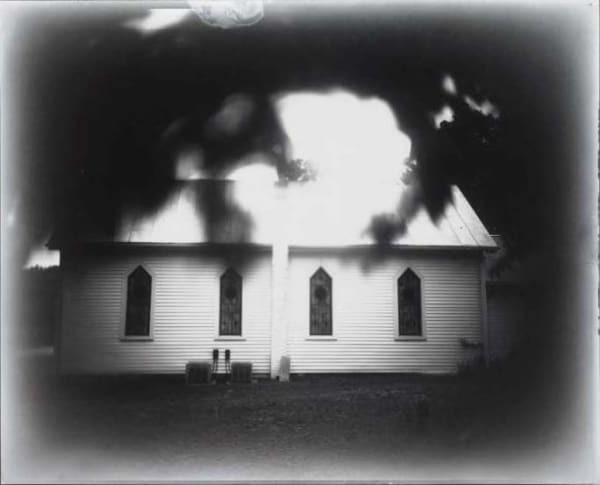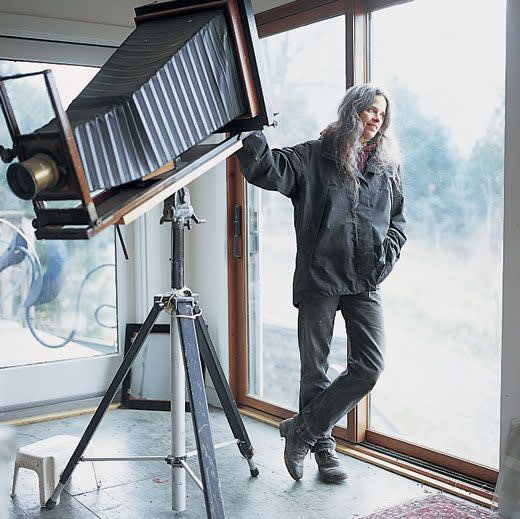Sally Mann
BIOGRAPHY
Sally Mann is one of the most significant American photographers of the late 20th and 21st centuries, known for her psychologically rich, formally daring images rooted in the cultural and physical landscape of the American South. Over a career spanning more than four decades, Mann has explored enduring themes of childhood, family, memory, mortality, and the passage of time, often through experimental and historic photographic processes.
Mann’s relationship with Edwynn Houk Gallery began with the debut of her celebrated series At Twelve: Portraits of Young Women (1988), a nuanced study of girls on the cusp of adolescence. These black-and-white portraits introduced her signature combination of technical precision, emotional honesty, and Southern sensibility. Since this presentation, Edwynn Houk Gallery has continued to present key series by the artist, Immediate Family, Mother Land, and Deep South and actively facilitates secondary market placements of sold-out works.
Her landmark series, Immediate Family (1985–1994), presents deeply intimate, occasionally staged photographs of her three children—Emmett, Jessie, and Virginia—taken at the family’s remote cabin in Virginia’s Shenandoah Valley. Using an 8×10 view camera, Mann created unflinching images that capture both the immediacy and complexity of childhood: play, solitude, conflict, and transformation. “Every mother has seen everything I’ve photographed,” Mann has said, “probably countless times.” This series was first exhibited at Edwynn Houk Gallery in Chicago in 1990, with the New York presentation bringing national recognition and a 1992 cover story in The New York Times Magazine.
As her children matured, Mann turned her lens toward the land itself, using the American South as a site of both personal and collective memory. Her projects Deep South, Mother Land, and Last Measure trace landscapes marked by history, trauma, and reverence. From the battlefields of the Civil War to quiet backroads in Virginia and Mississippi, her photographs reflect on the legacy of place and the weight of memory.
Mann embraced the 19th-century wet-plate collodion process for many of these works—a labor-intensive technique whose imperfections mirror the fragility of the histories she explores. The resulting images are ghostly and tactile, with surface flaws that underscore the haunted, physical presence of the past.
institutions & RECOGNITION
Mann's work is held in major museum collections, including the Museum of Modern Art (MoMA), the Metropolitan Museum of Art, the National Gallery of Art, and the J. Paul Getty Museum. Mann is a Guggenheim Fellow and a three-time recipient of the National Endowment for the Arts fellowship. In 2018, Mann was honored with the mid-career retrospective Sally Mann: A Thousand Crossings, organized by the National Gallery of Art and the Peabody Essex Museum. The show traveled through 2020 to the Getty Museum in Los Angeles, the Museum of Fine Arts in Houston, the Jeu de Paume in Paris, and the High Museum of Art in Atlanta.
Mann is also the subject of two major documentary films: Blood Ties: The Life and Work of Sally Mann (1994), nominated for an Academy Award, and What Remains (2006), which premiered at the Sundance Film Festival and received an Emmy nomination. Her memoir, Hold Still (2015), was a finalist for the National Book Award and received the Andrew Carnegie Medal for Excellence in Nonfiction.
In 2025, she will publish a new book of photographs titled Art Work: On the Creative Life, continuing her exploration of the Southern landscape and its emotional topography.
Sally Mann lives and works in Lexington, Virginia.
-
 Sally MannTriptych, 2004
Sally MannTriptych, 2004 -
 Sally MannEmmett, Jessie and Virginia, 1994
Sally MannEmmett, Jessie and Virginia, 1994 -
 Sally MannUntitled (Cindy and the Dog Statue), 1983-85
Sally MannUntitled (Cindy and the Dog Statue), 1983-85 -
 Sally MannDirty Jessie, 1985
Sally MannDirty Jessie, 1985 -
 Sally MannLuncheon in the Grasses, 1991
Sally MannLuncheon in the Grasses, 1991 -
 Sally MannPunctus, 1992
Sally MannPunctus, 1992 -
 Sally MannMiss Virginia, 1983-1985
Sally MannMiss Virginia, 1983-1985 -
 Sally MannVinland, 1992
Sally MannVinland, 1992 -
 Sally MannOlivia in the Chair, 1983-1985
Sally MannOlivia in the Chair, 1983-1985 -
 Sally MannGoosebumps, 1990
Sally MannGoosebumps, 1990 -
 Sally MannDeep South, Untitled (Avery Moss), 1998
Sally MannDeep South, Untitled (Avery Moss), 1998 -
 Sally MannDeep South, Untitled (Scrim), 1998
Sally MannDeep South, Untitled (Scrim), 1998 -
 Sally MannDeep South, Untitled (Avery Island II), 1998
Sally MannDeep South, Untitled (Avery Island II), 1998 -
 Sally MannBattlefields, Untitled, Cold Harbor (Battle), 2003
Sally MannBattlefields, Untitled, Cold Harbor (Battle), 2003 -
 Sally MannEmmett #3, 2004
Sally MannEmmett #3, 2004 -
 Sally MannVirginia #38, 2004
Sally MannVirginia #38, 2004 -
 Sally MannPonder Heart, 2009
Sally MannPonder Heart, 2009 -
 Sally MannPink Chair, 2016-17
Sally MannPink Chair, 2016-17
-

Heatwave
19 June - 25 July 2025Read more -

New Construction(s)
15 March - 19 April 2025Read more -

In the Studio
4 June - 3 August 2024Read more -

About Time
15 February - 30 March 2024Edwynn Houk Gallery presents About Time, an exhibition exploring the creative ways the concept of time, or the times, is interwoven into pictures, on view from February 15 to March 30, 2024.Read more
-

Summer Show 2023
17 July - 25 August 2023Read more -

Summer Show 2021
22 May - 26 August 2021Read more -

ADAA Autumn Online Viewing Room
14 September - 30 November 2020Read more -

ADAA Summer Online Viewing Room
1 June - 14 September 2020Read more
-

Summer Show: A selection of gallery artists and new acquisitions
10 July - 10 August 2018Read more -

Summer Show
20 July - 14 August 2015Read more -

Sally Mann: Upon Reflection
13 September - 3 November 2012Edwynn Houk Gallery is pleased to premiere an exhibition of new photographic self-portraits by Sally Mann (American, b. 1951) from 13 September through 3 November 2012.Read more -

Sally Mann: Immediate Family
29 November 2007 - 12 January 2008Read more
-

Sally Mann: Mother Land
Recent Landscapes of Georgia and Virginia 25 September - 8 November 1997After 12 years of photographing her family, Sally Mann's focus has shifted to the landscape of her native Virginia and southern neighbor, Georgia, in the series "Mother Land."Read more -

Sally Mann: Recent Work
14 September - 4 November 1995Read more -

Sally Mann: Immediate Family
5 May - 27 June 1992See the works featured in Houk Friedman's 1992 exhibition Sally Mann: Immediate Family, the gallery's second show of the celebrated series by one of America's most important contemporary photographers.Read more -

Sally Mann: Immediate Family
6 September - 31 December 1990Read more
-

Summer 2025 Group Show 'Heatwave' in Musée Magazine
Exhibition Review 22 July 2025Musée Magazine spotlights the exhibition Heatwave , on view at Edwynn Houk Gallery through July 25. The show brings together works by Lillian Bassman, Sally...Read more -

New Book by Sally Mann Arriving September 9, 2025
Art Work: On the Creative Life 10 June 2025Sally Mann is set to release her second book, Art Work: On the Creative Life, on Septemer 9, 2025. The article and Amazon link provide an overview of what her book is about and where you can pre-order it.Read more -

Sally Mann to receive a Lifetime Achievement Award
Sally Mann honored at 2025 CPW Vision Awards 1 May 2025Sally Mann will receive the Lifetime Achievement Award at the 2025 CPW Vision Awards, honoring over four decades of her evocative black-and-white photography exploring family,...Read more -

We Should Have Seen What Sally Mann Saw 40 Years Ago
Sally Mann in the New York Times 31 March 2025The New York Times publishes an opinion piece on the impact of Sally Mann's series, "At Twelve" (1983-85).Read more -

On and Off Stage: Performance and Persona at Addison Gallery of American Art, Phillips Academy, Andover, MA
Work by Sally Mann Included 22 February 2025February 22, 2025 – July 31, 2025 | Addison Gallery of American Art, Phillips Academy, Andover, MA On and Off Stage: Performance and Persona explores...Read more -

American Photography at the Rijksmuseum
Works by Sally Mann and Robert Frank included 7 February 2025Sally Mann and Robert Frank are featured in the group exhibition American Photography at the Rijksmuseum in Amsterdam, on view until June 9, 2025. This landmark group exhibition showcases over 200 works by renowned photographers, including Diane Arbus and Carrie Mae Weems. It offers a thematic exploration of American identity, protest, consumerism, and everyday life through the lens of both iconic and overlooked image-makers.Read more -

Sally Mann at the Modern Art Museum of Fort Worth, Texas
Diaries of Home 12 November 2024On view November 17, 2024–February 2, 2025 Diaries of Home features works by women and nonbinary artists who explore the multilayered concepts of family, community,...Read more -

Sally Mann at the Millennium Gallery, Sheffield, England
Acts of Creation: On Art and Motherhood 1 November 2024Sally Mann's photography is included in the traveling exhibition Acts of Creation, a show that originated at the Haywood Gallery and aims to address a blind spot in art history by asserting the artist mother as an important cultural figure.Read more -

Sally Mann at the Lewis Center for the Arts, Princeton University
Poetic Record: Photography in a Transformed World 1 October 2024Sally Mann's artwork is on view in the group exhibition Poetic Record: Photography in a Transformed World at Princeton University, New Jersey.Read more -

"Fragile Beauty: Photographs from the Sir Elton John and David Furnish Collection" at the Victoria & Albert Museum, London
18 May 2024 - 5 January 2025 18 May 2024“Fragile Beauty: Photographs from the Sir Elton John and David Furnish Collection” is on view at the Victoria & Albert Museum in London through January...Read more -

Sally Mann at Palazzo Tiepolo Passi
I’m Not Afraid of Ghosts exhibition 1 April 2024I’m Not Afraid of Ghosts , on view at Palazzo Tiepolo Passi in Venice through September 22, 2024, brings together works by 33 international artists...Read more -

Sally Mann Elected to the American Academy of Arts and Sciences
18 September 2023Sally Mann was elected to the American Academy of Arts and Sciences in 2022.Read more -

Sally Mann: Lucie Award
14 September 2022Sally Mann is the 2022 recipient of the 19th annual Lucie Award for Achievement in Fine Art.Read more -

Sally Mann: Prix Pictet
16 December 2021Sally Mann was announced December 15 as the winner of the 9th cycle of the Prix Pictet, the global award in photography and sustainability. The...Read more -

"Picturing the South: 25 Years" at the High Museum of Art
Work by Sally Mann and Abelardo Morell 1 November 2021The High Museum's exhibition "Picturing the South: 25 Years," which celebrates a quarter century of the museum's initiative, revisits important works by commissioned artists, including Sally Mann and Abelardo Morell.Read more -

Sally Mann: OPUS Award
1 September 2021Sally Mann is the 2021 recipient of the annual OPUS Award, presented by the Ogden Museum of Southern Art in New Orleans.Read more -

Wilde Kindheit at Lentos Kunstmuseum, Linz, Austria
Work by Sally Mann included 1 May 2021"Real Wild Child" presents artworks that explore the range of children's emotions, experiences, and perceptions. Work by Sally Mann is included.Read more -

New Orleans Museum of Art Acquires Transformative Gift of Photography from Dr. Russell Albright
Artworks by Brassaï, Man Ray, Manuel Alvarez Bravo, Bill Brandt, & Sally Mann added to collection 4 February 2021Dr. Russell Albright gifts significant photography collection to New Orleans Museum of Art, including artworks by Brassaï, Man Ray, Manuel Alvarez Bravo, Bill Brandt, & Sally Mann.Read more -

Sally Mann Awarded 2020 Centenary Medal
Royal Photographic Society Awards, celebrating excellence and innovation in photography 21 October 2020Instituted in 1993, the Centenary Medal is awarded in recognition of a sustained, significant contribution to the art of photography. The recipient of 2020's Medal is Sally Mann.Read more -

Virtual Views: Dorothea Lange: Words & Pictures, a Live Q&A
MOMA CURATOR SARAH MEISTER & SALLY MANN DISCUSS THE EXHIBITION 30 April 2020Artist Sally Mann and MoMA photography curator Sarah Meister discuss Dorothea Lange's enduring imagesRead more -

This Artwork Changed My Life: Sally Mann’s “Immediate Family”
Sally Mann on Artsy 7 January 2020Matt Williams describes how Sally Mann's photography changed his perspective on creation and art.Read more -

Expert Eye: Isaac Julien shares his favourite works at Art Basel in Miami Beach
EDWYNN HOUK AND SALLY MANN IN THE ART NEWSPAPER 7 December 2019Edwynn Houk Gallery's triptych of Sally Mann's "Faces" at Art Basel Miami Beach 2019 in the Art NewspaperRead more -

New Symphony of Time at the Mississippi Museum of Art, Jackson
Includes work by Sally Mann 7 September 2019Themes include migration, movement, and home; shared humanity; environment; and liberty. Work by Sally Mann is included.Read more -

The 50 Best Memoirs of the Past 50 Years
SALLY MANN IN THE NEW YORK TIMES 26 June 2019Sally Mann's autobiography "Hold Still: A Memoir with Photographs," published in 2015, named Best Memoir by the New York TimesRead more -

Sally Mann: A Thousand Crossings | The Museum of Fine Arts, Houston
A THOUSAND CROSSINGS MOVES TO THE MUSEUM OF FINE ARTS, HOUSTON 3 March 2019Sally Mann's major exhibition "A Thousand Crossings," organized by the National Gallery of Art and the Peabody Essex Museum, moves to the Museum of Fine Arts, HoustonRead more -

Review of 'Sally Mann: A Thousand Crossings' at The Getty
SALLY MANN IN THE LOS ANGELES TIMES 2 January 2019The show was jointly organized by the National Gallery of Art and the Peabody Essex Museum in Salem, Mass. It is weighted toward photographs made...Read more -

Notable Photo Books of 2018
Sally Mann & Abelardo Morell in PDN 3 December 2018 Read more -

Peabody Essex Museum: Reflecting on Sally Mann as Storyteller
INTERVIEW WITH CURATOR SARAH KENNEL 27 June 2018Like many students of art history, curator Sarah Kennel’s first introduction to Sally Mann came with Immediate Family. Published in 1992, Mann’s groundbreaking and controversial...Read more -

The Mournful, Magnificent Sally Mann
Sally Mann IN THE NATIONAL REVIEW 21 April 2018'Does the earth remember?” The infinitely gifted photographer Sally Mann asks this question in the catalogue of her great retrospective at the National Gallery in...Read more -

Sally Mann’s Haunted South
Sally Mann in the New York Times Art Review 29 March 2018The New York Times reviews "Sally Mann: A Thousand Crossings" at the National Gallery of Art, which gathers 40 years of elegiac photographs of her family, and the Southern landscape misted over by its past.Read more -

Family, Landscape, and Race in Sally Mann’s Photographs
Sally Mann in Hyperallergic 10 March 2018“How can a sentient person of the modern age mistake photography for reality?” asks the photographer Sally Mann in her memoir Hold Still . “Photographs...Read more -

Seeing the South Through Sally Mann’s Lens
Sally Mann in The Wall Street Journal 5 March 2018‘Sally Mann: A Thousand Crossings,” at the National Gallery of Art, reminds us that great photographs do not have meanings; they have agency. This is...Read more -

Sally Mann: A Thousand Crossings Monograph
SALLY MANN: A THOUSAND CROSSINGS, By Sarah Greenough and Sarah Kennel 1 March 2018For more than 40 years, Sally Mann (b. 1951) has made experimental, elegiac, and hauntingly beautiful photographs that explore the overarching themes of existence: memory,...Read more -

The National Gallery of Art’s Sally Mann exhibit shows the South as you’ve never seen it
Sally Mann in the Washington Post 28 February 2018Sally Mann: A Thousand Crossings at the National Gallery of Art considers how Mann’s relationship with this land has shaped her work and how the legacy of the South—as both homeland and graveyard, refuge and battleground—continues to permeate American identity.Read more -

THE COLOR OF HUMANITY IN SALLY MANN'S SOUTH by Hilton Als
Sally Mann in The New Yorker 28 February 2018We’re in Virginia, where the photographer Sally Mann was born, in 1951, and where she still lives, making work so rooted in place that it...Read more -

MFA Boston Exhibition "(un)expected families"
Includes work by Diane Arbus, Dorothea Lange, Abelardo Morell, Sally Mann & Harry Callahan 3 January 2018An exhibition at Boston's Museum of Fine Arts, "(un)expected families," explores how photographers have chosen to represent loved ones and the concept of family through an alternative lens.Read more -

12 Must-See Works at PHOTOFAIRS | San Francisco
Sally Mann featured on Artsy 27 January 2017Sally Mann made a name for herself through the photographs of her children, taken between 1984 and 1992, which she stopped around the time her eldest daughter turned 12.Read more -

Sally Mann's Exposure
Artist writes article in the New York Times Magazine 16 April 2015What an artist captures, what a mother knows and what the public sees can be dangerously different things.Read more -

Pictures by Women: A History of Modern Photography
MoMA Exhibition Celebrates Female Photographers 7 May 2010For much of photography’s 170-year history, women have expanded its roles by experimenting with every aspect of the medium. Pictures by Women: A History of...Read more -

Model Family
Sally Mann in Smithsonian Magazine 1 May 2005Sally Mann’s unflinching photographs of her children have provoked controversy, but one of her now-grown daughters wonders what all the fuss was aboutRead more -

Art in Review: Sally Mann, "Last Measure"
Review in The New York Times 24 November 2003Edwynn Houk Gallery 745 Fifth Avenue, at 57th Street Through Nov. 15 The earth and its relationship to mortality are Sally Mann's terrain in this...Read more -

The Disturbing Photography of Sally Mann
Sally Mann in the New York Times 17 September 1992At the opening last spring of "Immediate Family," Sally Mann's show at the Houk Friedman Gallery in New York, the winsome young subjects of the photographs aroused as much curiosity as the artist herself.Read more
-
At Twelve: Portraits of Young Women, Aperture, 1988
-
Immediate Family, Aperture, 1992
-
Mother Land: Recent Landscapes of Georgia and Virginia, Edwynn Houk Gallery, 1997
-
Last Measure, Edwynn Houk Gallery, 2000
-
What Remains, Bulfinch Press, 2003
-
Deep South, Bulfinch Press, 2005
-
Faces, Gagosian, 2012
-
Hold Still: A Memoir with Photographs, Little, Brown, 2015
-
Sally Mann: A Thousand Crossings, National Gallery of Art and the Peabody Essex Museum, 2018
-
Art Work: On the Creative Life, Little, Brown, 2025





